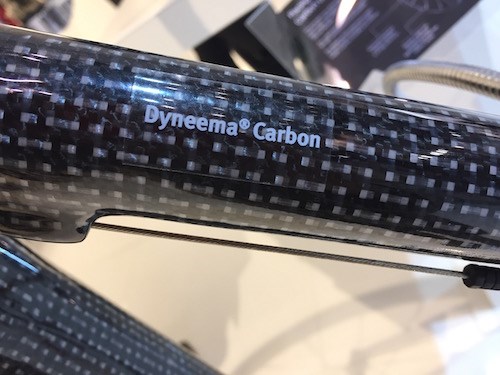Dyneema Carbon is prepared to handle all impacts
By marrying carbon with Dyneema, impact energy absorption can reportedly be increased by up to 100% while removing the risk of splintering.

During K 2016, DSM Dyneema showcased this racing bike made with Dyneema Carbon composite.
When it comes to materials science, there’s always room for innovation. Take carbon fiber. Yes, the material is strong and stiff but handling impacts has been a challenge. And this is why at K 2016, the representatives of DSM Dyneema couldn’t hide their excitement of their new product: Dyneema Carbon, which they launched at K. Dyneema Carbon is a hybrid of pure carbon fiber and Dyneema fiber that can be tailored to meet a variety of performance requirements. By marrying carbon with Dyneema, impact energy absorption can be increased by up to 100% while removing the risk of splintering. DSM claims that Dyneema Carbon hybrid composites are also lighter, less brittle and more vibration dampening than pure carbon composites.
The scientific explanation is that while carbon fiber shows the best strength-to-weight ratios for tension, compression and bending loadings, it shows poorer performance on impact loadings. Combining – hybridizing – carbon fiber with Dyneema UHMwPE fiber (ultra-high molecular weight polyethylene) results in Dyneema Carbon hybrid composites that handle impact forces significantly better.
Now as part of a hybrid composite, Dyneema can bring its lightweight strength to products currently using pure carbon composites – covering everything from golf clubs to racing bikes to steering wheels.
During K 2016, I sat down with DSM Dyneema CEO Golnar Motahari Pour to learn more about this innovative material. Here are some highlights from the interview:
The why
“Carbon fiber is a great material but it is lacking in impact performance – ductility– so when we mix in Dyneema with carbon fiber, it gives you ductility,” Motahari Pour says. “Carbon fiber is already lightweight and stiff but it has drawbacks of being brittle…adding Dyneema complements the stiffness and improves ductility and improves the feel and contributes to a weight difference, making the composite lighter.”
This ability to replace up to half the carbon with Dyneema without significantly reducing the final composite’s typical ‘carbon fiber’ performance, reflects another useful property of Dyneema, according to the company. Dyneema fibers have a lower density than traditional carbon fiber. So, on a weight-for-weight basis, you can make the composite that contains Dyneema thicker than one that doesn’t.
Applications
Motahari Pour says the company is focusing on applications where impact, feel and vibration dampening is of utter importance. For instance, during K, DSM Dyneema displayed a racing bike that featured Dyneema Carbon composite. According to DSM, the bike frame has all the benefits of carbon fiber composites (stiffness and lightweight) with additional ductility and reduced vibration. Spokes are made with the Dyneema braid, with lightweight and reduced rotation intertia. The bike frame features Dyneema Carbon hybrid composite in an epoxy resin matrix.
In addition, Motahari Pour says field hockey sticks is another good application due to its need for stiffness and vibration dampening.
“We’re looking at expanding it to other sporting good applications and other composites applications where lightweight, impact, ductility and vibration dampening is a factor,” Motahari Pour says.
Racing cars is another major application and Motahari Pour says Toyota Motor sports is evaluating using this composite in body panels.
“We have just launched the material and already have several applications in development,” she says. “While replacing pure carbon and other hybrid composites are already out there, the vibration of Dyneema is much better.”

Related Content
TU Munich develops cuboidal conformable tanks using carbon fiber composites for increased hydrogen storage
Flat tank enabling standard platform for BEV and FCEV uses thermoplastic and thermoset composites, overwrapped skeleton design in pursuit of 25% more H2 storage.
Read MoreThe potential for thermoplastic composite nacelles
Collins Aerospace draws on global team, decades of experience to demonstrate large, curved AFP and welded structures for the next generation of aircraft.
Read MorePlant tour: Teijin Carbon America Inc., Greenwood, S.C., U.S.
In 2018, Teijin broke ground on a facility that is reportedly the largest capacity carbon fiber line currently in existence. The line has been fully functional for nearly two years and has plenty of room for expansion.
Read MoreMcLaren celebrates 10 years of the McLaren P1 hybrid hypercar
Lightweight carbon fiber construction, Formula 1-inspired aerodynamics and high-performance hybrid powertrain technologies hallmark this hybrid vehicle, serve as a springboard for new race cars.
Read MoreRead Next
Modeling and characterization of crushable composite structures
How the predictive tool “CZone” is applied to simulate the axial crushing response of composites, providing valuable insights into their use for motorsport applications.
Read More“Structured air” TPS safeguards composite structures
Powered by an 85% air/15% pure polyimide aerogel, Blueshift’s novel material system protects structures during transient thermal events from -200°C to beyond 2400°C for rockets, battery boxes and more.
Read MorePlant tour: A&P, Cincinnati, OH
A&P has made a name for itself as a braider, but the depth and breadth of its technical aptitude comes into sharp focus with a peek behind usually closed doors.
Read More






















